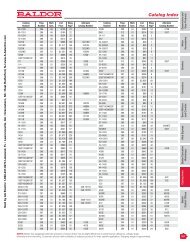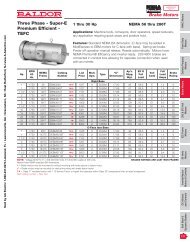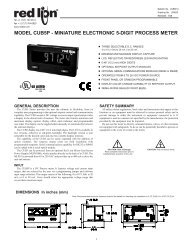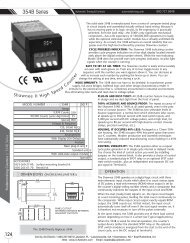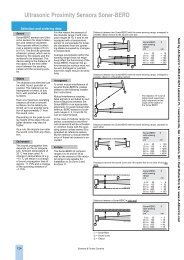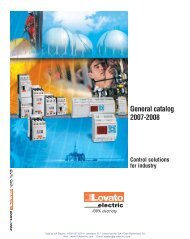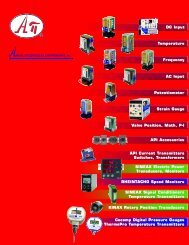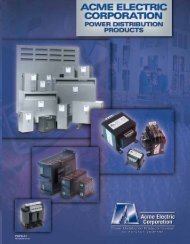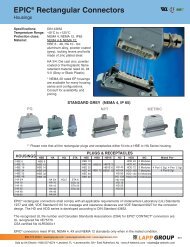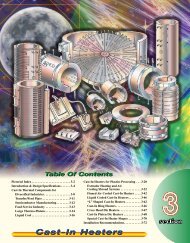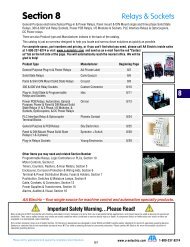G - AA Electric
G - AA Electric
G - AA Electric
You also want an ePaper? Increase the reach of your titles
YUMPU automatically turns print PDFs into web optimized ePapers that Google loves.
Optocoupler – Overview<br />
Control side of the optocoupler interface<br />
Optocoupler<br />
K<br />
Basic structure of the optocoupler<br />
interface:<br />
The key component is the actual optoelectronic<br />
unit (optocoupler) which is<br />
responsible for the coupling.<br />
One important variable of this component<br />
is the current transfer rate (CTR). The CTR<br />
factor is stated as a percentage and<br />
describes the ratioship between dispensed<br />
input current IF and the maximum available<br />
output current IC.<br />
Example: IF = 10 mA; CTR = 100 % =><br />
IC = 10 mA.<br />
However, the CTR variable is influenced<br />
by various parameters such as ambient<br />
temperature, degree of efficiency of the<br />
luminescence diode or geometric dimensions<br />
within the component, and itself<br />
declines over time. This means that the<br />
switching thresholds change over time,<br />
partly as a result of ageing.<br />
In order to eliminate this effect as far as<br />
possible, Weidmüller optocouplers use<br />
almost exclusively optoelectronic semiconductors<br />
with high long-term stability in<br />
terms of CTR behaviour.<br />
The insulation strength of the component<br />
is also important, because the actual coupling<br />
of the input and output circuits results<br />
from optical transfer. This means that even<br />
in the event of a fault, the optical component<br />
will guarantee separation of both circuits.<br />
By using optoelectronic coupling elements<br />
in accordance with DIN VDE 0884,<br />
Weidmüller’s optocouplers represent the<br />
ultimate in safety.<br />
The circuitry within the module as a whole<br />
also deserves to be mentioned, with features<br />
including “protective separation” in<br />
accordance with DIN VDE 0106 part 101.<br />
Optocouplers for galvanic isolation or<br />
“protective separation”<br />
Die Teilentladungsprüfung, nach<br />
The partial discharge level test as per<br />
DIN VDE 0884 is the primary prerequisite<br />
for “protective separation” with optoelectronic<br />
coupler modules. Double or reinforced<br />
insulation for “protective separation”<br />
must be partially discharge-proof.<br />
High-voltage testing, a standard procedure<br />
for relays, is not possible with semiconductors<br />
because it may actually<br />
destroy them. In the case of coupler<br />
modules with integrated optocouplers,<br />
“protective separation” for the specified<br />
rated voltage is achieved when the following<br />
requirements are satisfied:<br />
– Testing of the optocouplers as per<br />
DIN VDE 0884<br />
– Adherence to creepage and clearance<br />
path on circuit boards and connection<br />
elements in accordance with EN 50<br />
178, DIN VDE 0106 and 0109.<br />
A distinction is made between three basic<br />
circuits on the input side of the optocoupler<br />
interfaces:<br />
– Pure DC input<br />
Here there is a reversed polarity protection<br />
diode which prevents damage<br />
to the module in the case of reversed<br />
input polarity<br />
– AC/DC input<br />
(with DC signal trigger) is the lower<br />
switching frequency of the module,<br />
because the charge capacitor (CL,<br />
necessary for AC input signals)<br />
reduces the maximum switching frequency<br />
– AC input<br />
Here again, the charging capacity has<br />
a major influence on the maximum<br />
switching frequency of the module as a<br />
whole. Weidmüller optocouplers with<br />
AC/DC or AC input signals are rated<br />
for mains frequencies of approx.<br />
40 – 60 Hz. In the case of AC input<br />
signals, the maximum switching frequency<br />
of the optocoupler module is<br />
less than half the mains frequency. A<br />
higher switching frequency is not possible,<br />
because this would result in constant<br />
switching in the rhythm of the<br />
mains frequency.<br />
Load side of the<br />
optocoupler interface<br />
Weidmüller optocoupler modules have<br />
been dimensioned and developed for use<br />
in a wide range of applications and industries.<br />
Possible demands made on the load side<br />
of the optocoupler modules include:<br />
– power amplification<br />
– AC/DC and DC/AC signal conditioning<br />
– short-circuit protection<br />
– interference immunity<br />
To meet these requirements, the modules<br />
are assembled with additional electronic<br />
elements which then define the overall<br />
functioning of the optocoupler module.<br />
Accordingly, there are always two versions<br />
for the load side of the optocoupler:<br />
output as a 2-pole or 3-pole circuit.<br />
Sold by <strong>AA</strong> <strong>Electric</strong> 1-800-237-8274 Lakeland, FL • Lawrenceville, GA • Greensboro, NC • East Rutherford, NJ www.A-Aelectric.com<br />
Here it is not possible to reverse the<br />
polarity of the DC input signal. The disadvantage<br />
of the AC/DC input circuit<br />
K.50



